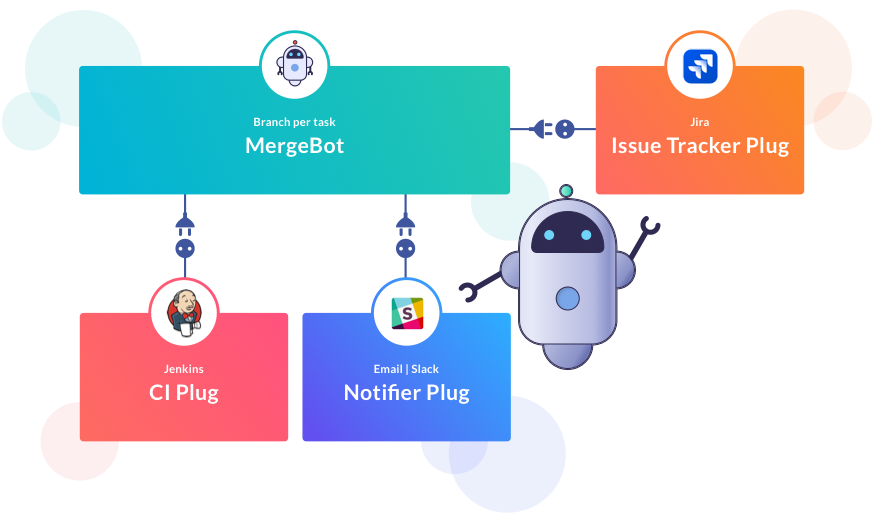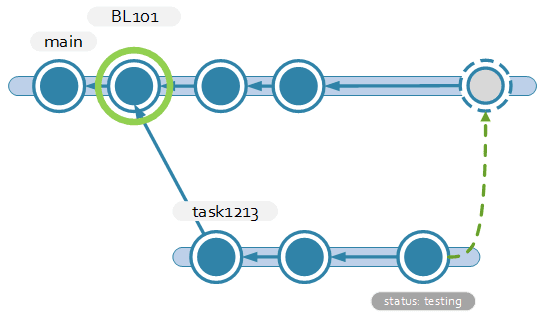The trunk mergebot is an implementation of a Trunk-Based Development DevOps cycle as we understand it in the Plastic SCM team.
This is the source code used by the actual built-in mergebot. Use it as a reference to build your own mergebot!
The executable is built from .NET Framework code using the provided src/trunk-mergebot.sln
solution file. You can use Visual Studio or MSBuild to compile it.
Note: We'll use ${DEVOPS_DIR} as alias for %PROGRAMFILES%\PlasticSCM5\server\devops
in Windows or /var/lib/plasticscm/devops in macOS or Linux.
If you just want to use the built-in trunk mergebot you don't need to do any of this. The trunkbot is available as a built-in mergebot in the DevOps section of the WebAdmin. Open it up and configure your own!
You'll notice some configuration files under /src/configuration. Here's what they do:
trunkbot.log.conf: log4net configuration. The output log file is specified here. This file should be in the binaries output directory.trunkbot.definition.conf: mergebot definition file. You'll need to place this file in the Plastic SCM DevOps directory to allow the system to discover your trunkbot.trunkbot.config.template: mergebot configuration template. It describes the expected format of the trunkbot configuration. We recommend to keep it in the binaries output directorytrunkbot.conf: an example of a valid trunkbot configuration. It's built according to thetrunkbot.config.templatespecification.
To allow Plastic SCM Server DevOps to discover your custom trunkbot, just drop
the trunkbot.definition.conf file in ${DEVOPS_DIR}/config/mergebots/available$.
Make sure the command and template keys contain the appropriate values for
your deployment! Your custom mergebot will be listed in the mergebot types page of
the WebAdmin under the "Custom" section.
The Trunk Bot, by its mergebot nature, is the central piece of the DevOps orchestration process. It's connected to the Plastic SCM Server, waiting for branches to be set to resolved. It also retrieves task information from issue trackers, triggers builds in external CI systems and it's able to notify the team about the progress and results of these operations.
Trunk Bot is our take on the trunk-based development methodology. It's engineered to monitor many short-lived feature branches (we also call them task branches) and automatically merge them when the developers finish implementing the feature and the resulting CI builds are successful. This changes the definition of Done, which now means delivered to production.
The first step begins when a user completes a task assigned to them. The related
task branch receives a value for the status attribute to mark it as resolved.
The information in the issue tracker updates as well to reflect that advance in
the task lifecycle and notify a fellow developer that it's time for the code review.
This attribute change sends a message to Trunk Bot. The resolved branch is now queued and pending to be processed. However, the bot won't take any further action until the code review is complete. This is when the Issue tracker plug comes into play: Trunk Bot will periodically poll the task issue to find out if the code review is complete. The code reviewer just needs to set the appropriate state in the task lifecycle to unlock the next step for Trunk Bot.
When the code review is complete and the branch is properly identified as resolved
in Plastic SCM, Trunk Bot will start a CI build using the CI plug. While
the task branch is processing, its status will change to testing in both Plastic
SCM (new value of the status attribute) and the configured Issue Tracker.
Trunk Bot ensures that the trunk branch stability is never broken. It temporarily
merges the task branch into the trunk branch and runs the CI builds in the resulting
shelve. So, if the CI build fails, the shelve would be removed and the merge would
roll back. No changes are committed to the repository. Also, the task status in the
issue tracker and the status attribute would be set to failed to notify the result.
However, if the merge operation isn't automatic (i.e. there are directory structure
conflicts or file conflicts that can't be automatically solved), Trunk Bot
considers that the branch processing failed, and it prompts the assigned developer
to solve the merge conflicts before the branch is again set as resolved. The
rate of automatic merges is improved thanks to our awesome SemanticMerge technology!
Finally, if there aren't any merge conflicts and the build results were correct,
then Trunk Bot attempts to commit the temporary merge to the trunk branch.
The shelve is promoted to changeset and your trunk is enhanced with the new feature
and a guaranteed stability! The task issue and the branch status attribute will
be set to a new merged value to show the progress in its lifecycle.
That's all! Trunk bot will work tirelessly monitoring your branches so that you and your team can focus on getting things done while the Plastic SCM DevOps ecosystem handles builds and merges. You might find interesting our blogpost about DevOps, too!
If you have any questions about this mergebot don't hesitate to contact us by email or in our forum!

